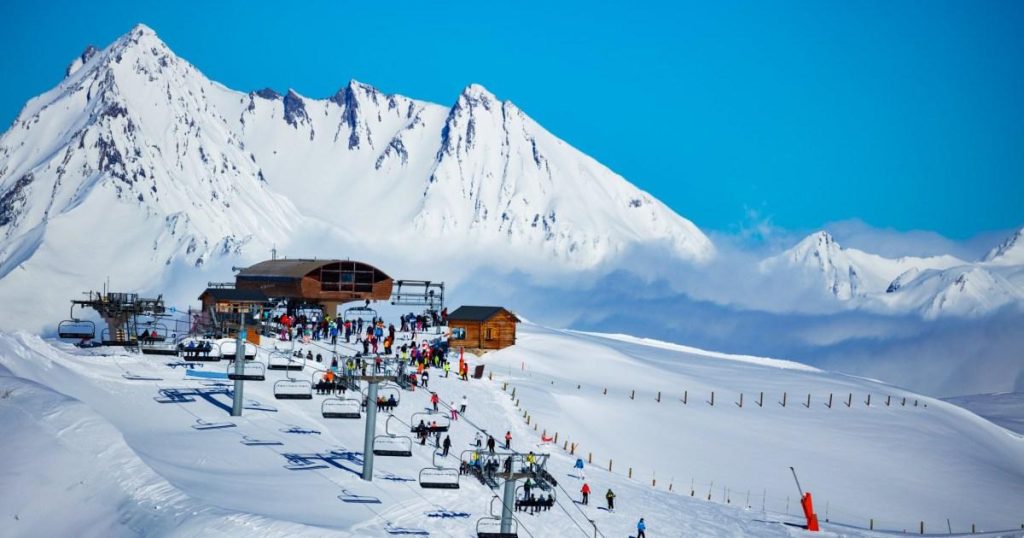A Tragic Collision on the Slopes of Les Arcs: A Detailed Account
The serene beauty of the French Alps was shattered on a Tuesday morning when a violent collision between two skiers on the challenging black slope of Aiguille Rouge at the Les Arcs resort claimed the life of a 62-year-old British woman. The incident, which occurred around 10:30 am, involved the woman and a stationary 35-year-old British man, both of whom were reportedly wearing helmets. The impact of the collision proved fatal for the woman, despite the swift response of ski patrollers and an emergency doctor who arrived on the scene to administer first aid. Resuscitation attempts were unsuccessful. The man involved in the collision survived, though the extent of his injuries remains undisclosed. The tragedy underscores the inherent risks associated with skiing, particularly on challenging slopes like the Aiguille Rouge, known for its steep gradient of at least 40% and designed for advanced skiers. This incident serves as a stark reminder of the importance of vigilance and safety precautions on the slopes, even for experienced skiers.
The Aiguille Rouge slope, where the tragedy unfolded, is nestled within the picturesque Les Arcs ski resort, situated in the French Alps near the Italian border, approximately 200 kilometers east of Lyon. The resort, a popular destination for skiers and snowboarders, boasts a variety of slopes catering to different skill levels. However, black slopes like Aiguille Rouge present a formidable challenge, demanding a high level of expertise and control. The gradient and often icy conditions on such slopes can amplify the consequences of even minor miscalculations or loss of control, making accidents more likely and potentially more severe. The tragic incident highlights the need for skiers to accurately assess their abilities and choose slopes appropriate to their skill level, especially when venturing onto challenging terrain like black slopes.
This unfortunate incident is not an isolated tragedy in the Alps. In recent months, the majestic mountain range has witnessed a series of heart-wrenching accidents, underscoring the inherent dangers lurking beneath its breathtaking beauty. In March of the preceding year, a British skier, believed to be in his sixties, lost his life after colliding with a tree while reportedly attempting to avoid a group of skiers. That same month, a family of five skiers perished from hypothermia after losing their way in the unforgiving Swiss Alps. More recently, an avalanche in the northern Piedmont region of the Italian Alps claimed the lives of three skiers, adding to the mounting toll of tragedies. These recurring incidents serve as a somber reminder of the unpredictable nature of mountain environments and the potential for unforeseen events to turn a joyous outing into a devastating tragedy.
The death of the British woman at Les Arcs casts a shadow over the skiing community and raises important questions about safety on the slopes. While skiing offers an exhilarating experience amidst stunning natural landscapes, it is crucial for skiers to remain aware of the potential risks and take necessary precautions. Choosing slopes appropriate to one’s skill level, maintaining control and speed, and adhering to safety guidelines are paramount for mitigating the risks associated with skiing. Black slopes, such as the Aiguille Rouge, demand utmost respect and should only be attempted by experienced skiers with the necessary skills and confidence. The tragic incident at Les Arcs serves as a poignant reminder of the fragility of life and the importance of prioritizing safety in the pursuit of adventure.
The investigation into the collision at Les Arcs is ongoing, and authorities are working to determine the precise sequence of events leading to the tragic outcome. Information gathered from witnesses, ski patrol reports, and any available video footage will be crucial in piecing together the circumstances of the collision. Understanding the factors contributing to the incident will not only provide closure to the families involved but also inform future safety measures and potentially prevent similar tragedies from occurring. The skiing community eagerly awaits the findings of the investigation, hoping that valuable lessons can be learned and implemented to enhance safety on the slopes.
The recurring tragedies in the Alps underscore the need for continuous efforts to improve safety measures and raise awareness among skiers and snowboarders. Clear and concise communication of safety guidelines, regular maintenance of slopes and equipment, and readily accessible emergency services are vital components of a comprehensive safety framework. Educating skiers about the potential risks, encouraging responsible behavior on the slopes, and promoting the use of safety equipment such as helmets can contribute significantly to reducing accidents and enhancing the overall safety of the skiing experience. Collaboration between resort authorities, ski instructors, and the wider skiing community is essential in fostering a culture of safety and ensuring that the mountains remain a place of enjoyment and adventure for all.











